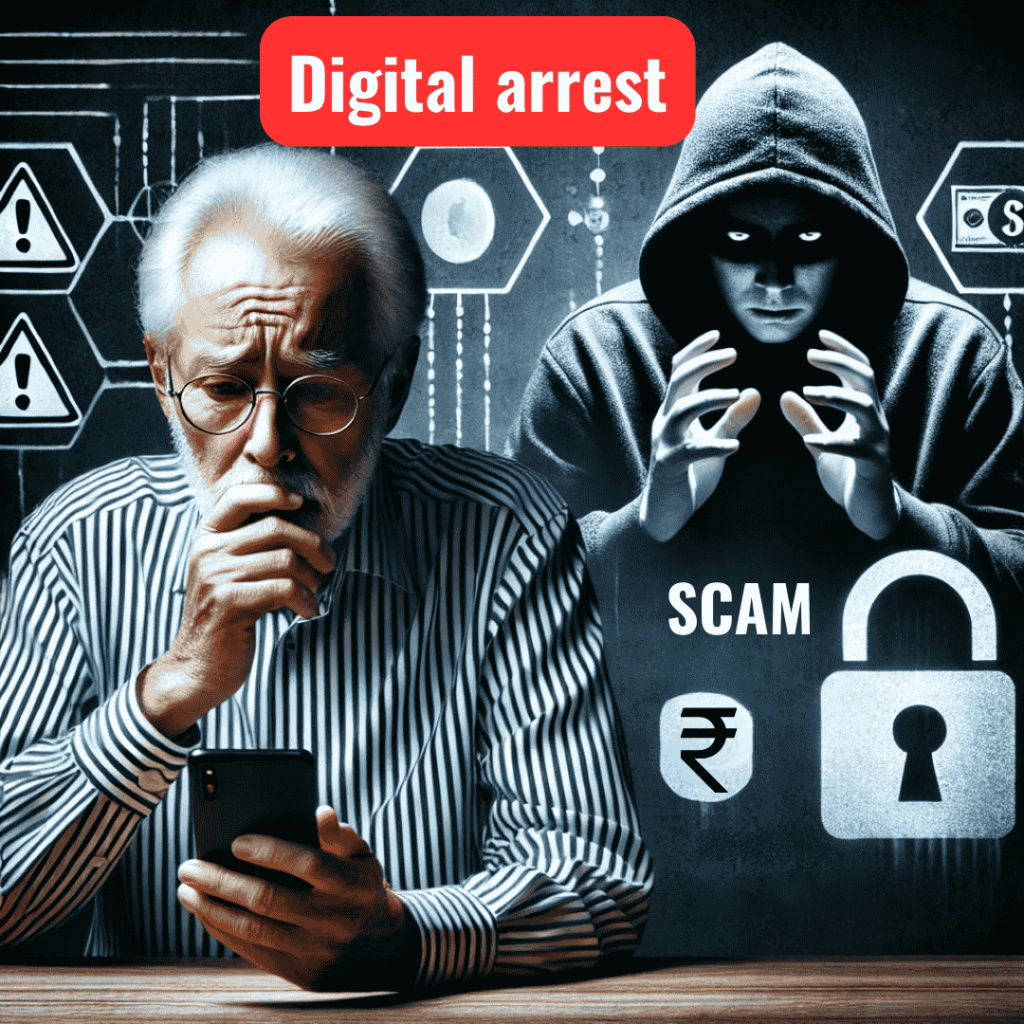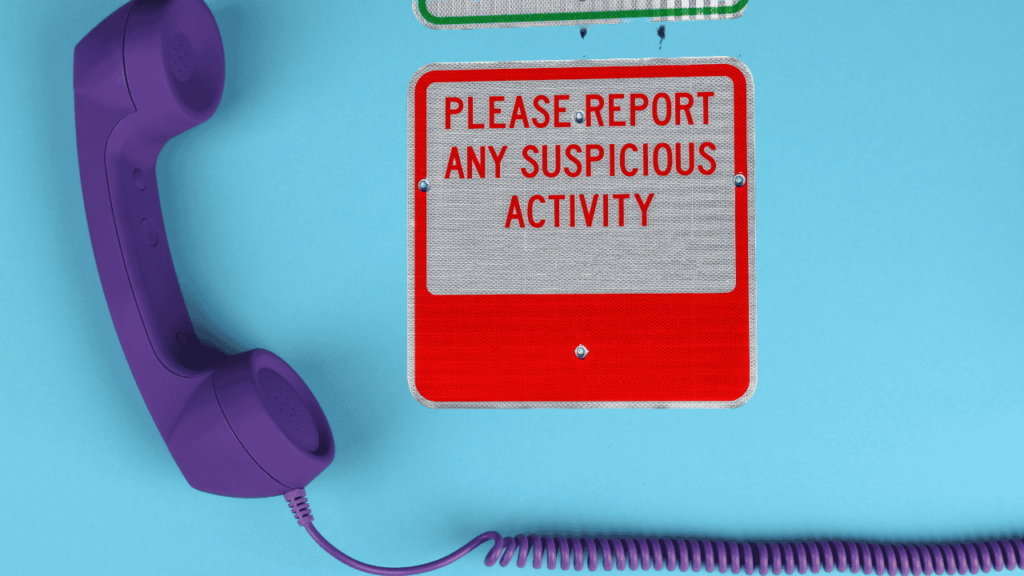
In today’s world, scams come in many shapes and forms. One alarming example is the “digital arrest” scam. This scam tricks people into believing that they have been officially arrested or implicated in a crime, often using technology and intimidating language. The scam works by playing on a victim’s fear and causing immense psychological stress.
I thought this was one type of online fraud, which is already prevalent and did not bother about this much, until I heard a shocking news of one of my fellow colleague’s relative (aged around 63 years) fell into this online fraud trap of “Digital arrest”, and that too, he had lost close to Rs. 55 lakhs, his full life savings. The more concerning point is that he was a retired college Professor, yet he has been tricked into this new scam and has been made to lose his full life savings.
Hence, I thought I should write this blogpost, for readers to be beware of such scams and be cautious. In this blogpost, we will see how this scam works, whether the government is doing enough to curb the menace, and how you can keep yourself safe.
Let us see in detail how the victims undergo the “digital arrest” ordeal.
Table of Contents
What is a Digital Arrest scam?
A digital arrest scam is a type of fraud where criminals pretend to be law enforcement or government officials. They call the victim, usually using an unlisted or spoofed number, and deliver a message filled with threats and urgency. The scammer claims that the victim is under investigation or has been involved in serious criminal activities. They say that a package or important document linked to the victim has been seized, or that the victim’s digital devices are being misused. The objective is to scare the person into following instructions without questioning them.
These scammers create an atmosphere of panic. They may say that if the victim does not act immediately, there will be severe consequences not only for the victim but also for the victim’s family members. In some cases, the victim is told to cut off all communications with friends and family, leaving them isolated and more vulnerable to the scammer’s control. The scam is called “digital arrest” because the victim is, in a sense, held hostage over the phone or online until they comply with the scammer’s demands.
The Modus Operandi: How the scam works
The process of a digital arrest scam is often similar in each case, though scammers may change details to confuse their targets. Here is how a typical scam unfolds:
- The Initial Contact: The scam often begins with a call from an unknown, international, or unlisted number. An automated message might inform the victim that a courier or package, supposedly sent to them, has been cancelled or intercepted.
- Following Instructions: The automated voice typically instructs the victim to press a specific number (for example, “0”) to speak with a customer support representative. Unfortunately, many people follow these instructions without much thought.
- Meeting the “Representative”: Once the victim presses the button, they are connected to someone claiming to be a customer support agent. This person then explains that the package contained items of a criminal nature, sometimes even listing drugs or expensive items, implying that the victim is somehow involved in criminal activities.
- Escalation with Fake Authorities: The scammer then transfers the call to another individual who pretends to be an official from a local police department or another government agency. At this stage, the victim is told that they are a prime suspect in crimes like money laundering, drug trafficking, or other serious offenses. The impostor gives strict instructions: do not talk to anyone, do not call back any numbers, and keep all communications secret.
- Isolation and Coercion: Under the impression that they are being formally detained, the victim is urged to follow all directions given by the scammer. They are warned that if they try to contact family or friends, everyone could be in danger. This isolation is critical because it ensures that the victim has no one to turn to for help or advice.
- Financial Exploitation: While the victim is under this intense pressure, the scammers force them to transfer money from their bank account. In many cases, the scam lasts anywhere from 40 to 48 hours, during which the victim’s account is drained of funds—sometimes even all of their life savings.
A Closer Look: The Story of Suresh
To better understand how these scams unfold, consider the case of a man we will call Suresh. Suresh, a retired college professor, received an unexpected call from an unlisted international number. The call began with an automated message saying that a courier meant for him had been cancelled. Following the automated instruction, Suresh pressed the number zero, hoping to resolve the issue.
Soon, he was connected to someone who claimed to be a customer support representative. This person explained that the package had been intercepted because it supposedly contained illegal items. Not long after, Suresh’s call was transferred to another caller who introduced himself as an officer from the Mumbai Police. This “officer” informed Suresh that he was a suspect in a serious case involving money laundering and drug trafficking.
The impostor was relentless. He told Suresh that he must not answer any other calls or speak to anyone about this issue, not even his family. The scammer promised severe consequences if Suresh tried to verify the situation with anyone else, including threatening to harm his family members’ future prospects.
For almost 48 hours, Suresh was trapped in this digital arrest scenario. He was forced to follow instructions, and in his growing panic, he transferred nearly Rs. 55 lakhs from his bank account. By the time he realized the scam was unfolding, it was too late; his entire life savings had been lost, and the emotional trauma he experienced was immense.
What do the numbers tell us?
Unfortunately, Suresh’s story is not an isolated incident. Data collected by the Indian Cyber Crime Coordination Centre (I4C) paints a worrying picture of the scale of digital arrest scams. In 2024 alone, financial losses from these scams in India have been estimated to exceed ₹500 crore. This staggering number highlights how prevalent and damaging these scams have become.

With the rapid digitalization of India, more and more people are using online services and mobile phones. While this technological progress brings many benefits, it also opens up new avenues for cybercriminals. Many people are not fully aware of the risks that come with this digital age. The lack of digital literacy and awareness, especially among the older population, makes them easy targets for scammers.
Modern technology, including deepfake videos, sophisticated forensics tools, and realistic video calls, is now being exploited by fraudsters. They use these tools to create fake identities and documents that look official. Even individuals who are tech-savvy or well-educated can sometimes be deceived by these high-tech scams. However, data show that senior citizens are often the primary targets, as they are more likely to have savings and less familiarity with digital threats.
Who are the scammers targeting?
A common trend in these scams is that older, retired individuals are frequently targeted. The reason behind this is simple: many seniors have accumulated savings over their lifetimes, and scammers see an opportunity to exploit this financial security. In several reported cases, elderly people have lost large sums of money through digital arrest scams.
For example, there have been news reports of high-ranking retired officials being targeted. In one case from August 2024, a 79-year-old retired Major General residing in Noida was placed under digital arrest for five days. The scammers told him that a courier sent to him contained multiple passports, bank credit cards, and even a laptop, along with other suspicious items. They then coerced him into transferring Rs. 2 crore from his account. In another incident in October 2024, a retired Major General was tricked into paying Rs. 83 lakh after receiving a call that falsely claimed his mobile phone was being misused.
It is important to note that while seniors are the most common targets, younger and middle-aged individuals are not completely safe either. The scammer’s tactics are designed to work on anyone who is caught off guard, regardless of age. However, the potential financial impact is often higher for those who have built up significant savings over the years.
How do scammers identify their victims?
Scammers often have access to personal information from various organizations that handle sensitive data. Companies in the healthcare, finance, and government sectors store personal details about their customers, and sometimes these systems have weak security measures. When a company’s security is not robust, fraudsters can easily obtain the information they need to target vulnerable individuals.
In many cases, the scammers do not even need to use advanced hacking techniques. They can simply search for publicly available data or use information from companies that have not secured their databases properly. Once they have this information, they create a profile of potential victims and begin their scam operations.
The problem is compounded by the fact that many of these scams are cross-border. Criminals operating from other countries, such as Myanmar, Laos, Cambodia, or Vietnam, use sophisticated tools to hide their true locations. This makes it very difficult for local authorities to track down and prosecute them, further emboldening the scam artists.
Official warnings and Government actions
Recognizing the rising threat of digital arrest scams, authorities in India have started to issue warnings and take steps to protect citizens. Even the highest levels of government have spoken out about the dangers posed by these scams. For instance, during an episode of the popular radio program “Mann Ki Baat,” Prime Minister Narendra Modi highlighted the increasing number of digital arrest cases and advised citizens to “Stop, Think and Take Action.”
This simple three-step advice is crucial for anyone who receives a suspicious call. The first step is to remain calm and not panic. The second step is to carefully consider whether the call is genuine, remembering that official agencies rarely, if ever, conduct investigations over a phone call. The final step is to act by contacting the appropriate authorities or seeking advice from trusted family members.
In addition to public advisories, the government has also been working with telecom service providers to block international spoofed calls. These are calls that appear to be coming from Indian numbers even though they originate from overseas. By designing systems to filter and block such calls, the authorities hope to reduce the number of scam attempts. However, while these measures help, the ultimate responsibility to remain vigilant still rests on each individual.
What should you do if you receive a suspicious call?

If you ever receive a call that seems to be a digital arrest scam, here are some steps you can follow to protect yourself:
- Stay Calm: The moment you feel scared or pressured, take a deep breath. Do not allow fear to force you into hasty decisions. Scammers thrive on panic, and keeping a cool head is your first line of defense.
- Do Not Share Personal Information: Never provide details such as your full name, address, bank account numbers, or any other personal data over the phone. Genuine officials would never ask for such information in an unsolicited call.
- Verify the Caller’s Identity: If the caller claims to be from the police, a bank, or any government agency, hang up and contact the institution directly using a number you know is official. Check their website or use a trusted source to confirm whether the call was legitimate.
- Do Not Follow Unverified Instructions: Scammers may instruct you to transfer money or to perform specific actions immediately. Remember that real investigations or official procedures do not demand instant payments over the phone. Any request for money should be treated as a major red flag.
- Alert a Family Member or Friend: Isolation is one of the scammer’s tools. If you are ever instructed to cut off communication with loved ones, do not obey. Instead, tell someone you trust about the call immediately.
- Contact Your Bank Quickly: If you suspect that you have already shared sensitive financial information or made a payment, get in touch with your bank right away. Banks often have a small window, usually 15 to 20 minutes, during which transactions can be halted or reversed.
- Keep a Record of the Call: If possible, record the details of the call. Save any messages, write down the phone numbers used, and note the time and content of the conversation. This evidence can be very useful when reporting the incident to cybercrime authorities.
Recognizing the Red Flags: What makes a Digital Arrest scam fake?
It is essential to be aware of the characteristics that make digital arrest scams clearly fake. Here are some common signs that the call you received is part of a scam:
- Unsolicited Contact: Legitimate agencies do not make random calls to inform you about legal issues or investigations.
- Pressure to Act Immediately: A genuine investigation will never demand immediate payment or urgent actions over the phone. Scammers create a false sense of urgency to prevent you from thinking clearly.
- Isolation from Loved Ones: If the caller instructs you not to discuss the matter with anyone, it is a strong sign that something is amiss. Official procedures typically encourage transparency and communication with your family or legal advisors.
- Unverifiable Caller Identity: When you try to verify the caller’s details, if you find that the phone number or credentials cannot be confirmed through official channels, this is a clear red flag.
- Requests for Money: No authentic investigation or legal process will require you to pay money immediately over the phone to prove your innocence or to resolve the issue.
What to do if you fall victim
Despite all precautions, some people might unfortunately become victims of these scams. If you find yourself in this situation, here are the steps you should follow:
- Freeze Financial Transactions: Immediately contact your bank. Explain the situation and ask them to freeze any transactions related to the suspicious activity. Quick action can sometimes limit the damage and recover some of the funds.
- Collect and Preserve Evidence: Save all evidence related to the scam. This includes call recordings, messages, bank transaction details, and any written communication. The evidence will be crucial when you report the scam to the police or cybercrime authorities.
- Report the Incident: Reach out to the National Cyber Crime Helpline by dialing 1930 or visit the official Sanchar Saathi Portal to file a complaint. Provide all the details and evidence you have collected. The more information you share, the better the chances are for law enforcement to take action against the scammers.
- Monitor Your Credit and Bank Accounts: After the incident, keep a close watch on your financial accounts. Look for any unauthorized transactions or changes. You may also consider working with credit bureaus to monitor and dispute any discrepancies caused by the scam.
Steps to Protect Yourself from Digital Arrest Scams
The best defence against digital arrest scams is knowledge and vigilance. Here are some practical tips to help you stay safe:
- Educate yourself: Learn about common scam tactics and stay updated on the latest fraud trends. The more you know about how these scams work, the less likely you are to fall for them.
- Be cautious with unknown numbers: Avoid answering calls from international or unlisted numbers. If you do pick up such a call and something sounds unusual, consider ending the call immediately and verifying the information independently.
- Use trusted sources for information: Rely only on official websites and verified sources when you need to check on any information related to legal or financial matters. Do not trust information from random search engine results or social media posts when it comes to sensitive issues.
- Maintain open communication: Inform your close family members and friends about the possibility of such scams. A trusted person’s opinion can help you see through any suspicious claims made over the phone.
- Strengthen your digital security: Keep your personal and financial data secure. Use strong passwords, update your security settings regularly, and be aware of any breaches or vulnerabilities in the systems you use.
- Stay alert to Government advisories: Pay attention to public warnings and advice issued by government officials or recognized authorities. When leaders like the Prime Minister advise caution, it is a signal to take extra care.
Red Flags: How to tell a genuine call from a scam

Here are a few key points that can help you distinguish between a genuine call and a scam:
- Government and Police Protocols: No government agency or police department will call you unexpectedly to inform you about an arrest or investigation. They will always follow a formal process and never demand money over the phone.
- Payment Requests: Legitimate procedures never involve the immediate transfer of money. If a caller demands payment as part of resolving any issue, it is almost certainly a scam.
- Verification Methods: Authentic calls allow you to verify the caller’s identity by calling back through official numbers. If the caller insists that you cannot speak to anyone else, be wary.
Additional Advice for Preventing Digital Arrest Scams
- Do not rely on online searches alone: When trying to verify a call or any suspicious message, use official channels rather than a random online search. Scammers often upload fake numbers and details on the internet, making it hard to trust everything you read.
- Regularly check your bank statements: Make it a habit to review your bank statements and online transactions. Early detection of unusual activity can help you act quickly to prevent further losses.
- Stay informed about scam trends: Cybercrime is constantly evolving. By staying informed about the latest scam methods through news outlets, official government advisories, and trusted community groups, you can better protect yourself.
- Participate in community awareness programs: Sometimes, local police stations or community centers hold sessions on digital safety and scam prevention. Joining these sessions can boost your knowledge and provide practical tips on staying secure in a digital world.
Final Thoughts: Empower yourself against scams
Digital arrest scams are dangerous because they prey on fear and urgency. They use a mix of modern technology and old-fashioned trickery to isolate and pressure victims into handing over their money. Although the scammers often impersonate law enforcement or government officials, there are clear signs that reveal the scam for what it is.
Digital arrest scams are a clear example of how technology can be misused to inflict financial and emotional damage. By understanding the tactics used by scammers and following the advice laid out in this guide, you can protect yourself and help prevent the loss of hard-earned savings.
Take a proactive approach: educate yourself, share this information with others, and remain sceptical of any unsolicited calls or messages demanding urgent action. Remember, no genuine investigation or legal process will ever force you to make immediate payments or isolate you from your loved ones.
In conclusion, while digital arrest scams continue to evolve, your awareness and cautious behaviour are the most powerful tools you have. Keep your family informed, monitor your finances closely, and never hesitate to reach out to trusted authorities if something feels off. Together, by being cautious and well-informed, we can significantly reduce the impact of digital arrest scams and protect our financial security and peace of mind.
You can also check out my other blogpost on Cyber Fraud Threats.
Do Follow me on Linkedin and Quora for more such insightful posts on personal finance, money management, investments, retirement, etc.





